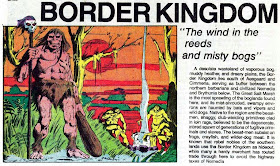Wednesday again. Time to re-enter the lost world with another installment of my issue by issue examination of DC Comic's Warlord
, the earlier installments of which can be found here...
"Something Evil"
Warlord (vol. 1) #49 (September 1981)
Writing and art by Mike Grell; inks by Vince Colletta
Synopsis: Resting by a creek, watching Morgan clean his pistol, Shakira suggests that some of his brashness comes from knowing he can rely on the gun to save him. She proposes a wager: she bets he can’t go from where they are to the next camp without using the gun to get get himself out of trouble. Morgan takes the bet.
As if on cue, Shakira notices an ancient structure peeking over the forest behind him. Upon investigation, they find the massive structure covered with inscriptions. Most have been worn away, but what Shakira can make out is a warning: this place is sacred to the Evil One, whoever that might be. As they look into the entrance and find an impaled skeleton, it’s clear that whoever he was, he wasn't hospitalble to visitors.
Paralleling the story of Morgan and Shakira’s exploration, we get a tale of the Age of Wizard Kings. It begins in the Great Fire Mountain, where the lowly
Craetur has secreted away the Necronomicon. He opens the tome and reads a spell, leading to him being consumed in hellfire and raising as the diabolic-appearing Evil One.
The Evil One subjugates Zarrgon Fire-Eye, his former master, and takes control of his castle. Desperate, Zarrgon secretly sends a message by bat to Mungo Ironhand and his friends---a message that is to affect the outcome of a battle fought thousands of years in the future.
In the Skartarian present, Shakira and Morgan make their way past traps, some already sprung on some would-be looters, and some still waiting. They press on, as Morgan’s sure there must be something here of value, given the number of people who've tried to get in. They’re unaware that their being stalked by a hungry leopard that entered the temple behind them.
They reach the main room where another skeletal treasure-hunter died at an altar with a crescent moon medallion in hand. Morgan places the golden crescent in the altar niche that fits it. A vibration begins in a large wall panel. Morgan barely has time to push Shakira out of the way before it explodes, to reveal:
The giant mummy attacks. Morgan dodges its blows, and cuts its arm with his sword, revealing the mummy’s insides are nothing but copious dust. Sword in one hand, dagger in the other, Morgan slashes furiously at the bandages holding the thing together until it collapses in a cloud of fifteen thousand year-old dust.
After pointing out to Shakira that he
didn’t use his pistol, Morgan says its time to go. Shakira asks about all the treasure, but Morgan’s only interest is finding his daughter.
At that moment, the leopard leaps from the shadows. In one swift motion, Morgan turns and shoots. The beast falls dead. Shakira compliments his shot--and tells him he lost the bet. Morgan reminds her they never decided on the stakes, but Shakira replies, “Let’s just say you owe me one.”
Elsewhere, in Castle Deimos, Jennifer Morgan lies sleeping. Suddenly, she awakens. Her eyes are wide with horror as she sees:
Things to Notice:
- This issue repeats the parallel story gimmick of issue #17.
- Zarrgon's name is misspelled Sarrgon this issue (as it was in his second appearance as well--so maybe his first appearance is wrong and his name is Sarrgon?)
Where It Comes From:
This issue's Age of the Wizard Kings story is a sequel to the back-up story in
issues 40-41. If Craetur was Gollum inspired, the Evil One is more of a
Dark Lord like
Sauron, though in appearance he resembles classic representations of the Devil.
The Evil One of the Age of Wizard Kings was first mentioned in
issue #31, which featured another booby-trapped tomb full of treasure. A similar altar with niches for metal shapes appeared in
issue #26.
















































